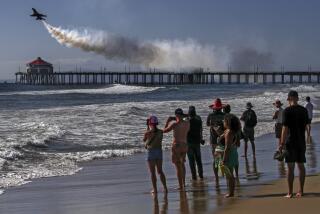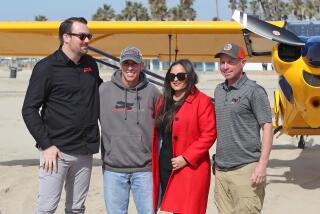Things are looking up for air shows
- Share via
Recession-weary families looking for affordable entertainment are increasingly turning to air shows as a source of cheap thrills, served up with a dollop of red, white and blue.
While theme parks and other family entertainment venues struggle for business in the slumping economy, attendance at air shows is up substantially this year -- by double-digit percentages at some venues.
And it’s not hard to see why. Getting two adults and two sub-10-year-olds through the gate at Disneyland for a day costs $256 without a discount coupon.
Getting the same group into the daylong air show at El Centro Naval Air Facility in March -- which featured a performance by the Blue Angels, the rocks stars of the air show world -- would have cost, well, nothing. Air shows at military bases, which account for about one-third of the air shows that will be staged in North America this year, don’t charge admission, and the parking is usually free.
Even shows that charge admission -- such as the Watsonville Fly-In & Air Show north of Monterey this weekend -- are a relative bargain. The industry’s average adult ticket price is $12.
“Compared to other types of entertainment, air shows still represent a good value,” said Bill Hamilton, general manager of the Planes of Fame Air Museum in Chino, where paid attendance at the annual air show last weekend was 20,000, up 35% over the year before.
“It’s still a good way for families to spend the day, and it doesn’t cost as much as some of the other alternatives,” he said.
The International Council of Air Shows, the industry’s trade group, estimates that 15 million people will attend air shows in North America this year, up from the typical annual attendance of 10 million to 12 million. The group says it saw the same pattern during the recessions of the early 1980s and ‘90s.
Besides being relatively inexpensive, air shows also have the advantage of ubiquity. With so many staged each year, most families can find one within reasonable driving time of home.
“People are trading down and they’re trading local, and it just makes sense given this economy that that would happen,” said Carl Winston, director of San Diego State University’s hospitality and tourism management program.
He said it’s another reflection of the recession-induced “stay-cation” trend -- the tendency for families to spend their vacations close to home, or even at home, to save money during hard times.
Air shows aren’t for folks seeking a contemplative getaway. With thunderous jet flybys, outrageous aerial stunts and heavy doses of pyrotechnics, they’re as subtle as a sonic boom on a quiet Sunday afternoon. But that may be part of the appeal in an era that has adopted extreme entertainment as the norm.
“Like everything else in the entertainment world, air shows have evolved to meet the increased expectations of the audiences that come to the events,” said John Cudahy, president of the air show council. “We’re competing with the X Games and wrestling, so the ‘wow factor’ has gone up considerably.”
With their emphasis on military aviation -- be it an appearance by the state-of-the-art F-22 Raptor or a simulated dogfight featuring World War II-era fighters -- air shows also can appeal to a taxpayer’s patriotic side.
“When you watch the Blue Angels fly multimillion-dollar airplanes a foot and a half away from each other, it’s hard not to be inspired by that,” Cudahy said.
Air show attendance is off to a mostly strong start this year, with shows in New Orleans and other locales reporting record crowds. Organizers of the Watsonville show are expecting 30,000 people, up significantly from last year.
But the swine flu scare and bad weather dampened turnout at some venues. And the strong performance at the gate has been needed to make up for a drastic falloff in sponsorships, which help cover the cost of putting on the show.
“On the surface, it looks like things are booming, but the industry is feeling the impact of the decline in sponsorships,” said Jim Breen, president of Carpinteria-based Umbrella Entertainment Group, which puts on around 20 air shows a year through its Air Show Network unit.
The three main air show sponsors are auto, financial services and beer companies, Breen said, and all three industries are going through financial turmoil or consolidation. And it costs serious money to mount an air show.
The Blue Angels alone can cost the organizer $40,000 in expenses, and Breen estimates his company spends more than $500,000 to put on the annual Fleet Week air show in San Francisco, which is free and draws more than 1 million spectators.
Breen is hopeful that those who are venturing out to an air show for the first time this season will become converts and come back next year.
“The key thing is the fans,” he said. “If the fans come, the sponsors will follow.”
--


